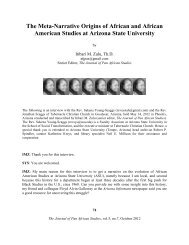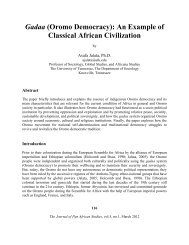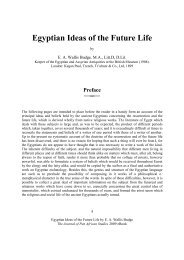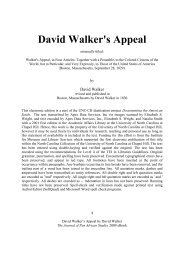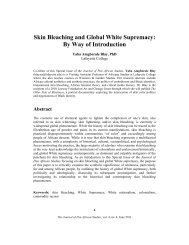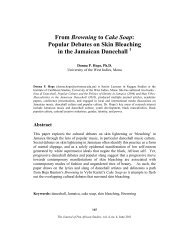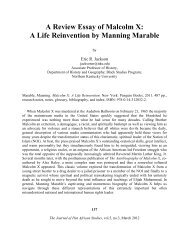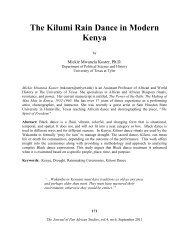The Adaptation of Swahili Loanwords From Arabic - Journal of Pan ...
The Adaptation of Swahili Loanwords From Arabic - Journal of Pan ...
The Adaptation of Swahili Loanwords From Arabic - Journal of Pan ...
Create successful ePaper yourself
Turn your PDF publications into a flip-book with our unique Google optimized e-Paper software.
<strong>The</strong> <strong>Adaptation</strong> <strong>of</strong> <strong>Swahili</strong> <strong>Loanwords</strong><br />
<strong>From</strong> <strong>Arabic</strong>: A Constraint-Based Analysis<br />
Abstract<br />
by<br />
Leonard Chacha Mwita, Ph.D.<br />
chachamwita8@yahoo.com<br />
Kiswahili Department, Kenyatta University<br />
This paper shows the processes that loanwords undergo when they are adapted from <strong>Arabic</strong> into<br />
Kiwahili. <strong>The</strong> data used is from Bosha (1993) and a constraint-based analysis is used in this<br />
paper. Although a number <strong>of</strong> studies have been carried out on Kiswahili loanwords, none that I<br />
know <strong>of</strong> has used Optimality <strong>The</strong>ory. This therefore makes the paper different from the others.<br />
Issues tackled herein include pitting the faithfulness <strong>of</strong> Kiswahili’s open syllabicity (NOCODA)<br />
against the markedness <strong>of</strong> the sonority hierarchy (SON-SEQ) in borrowed words. For example,<br />
the paper discusses whether to maintain NOCODA when syllabifying “sultani” (chief, ruler,<br />
king) as /su.lta.ni/ or whether to look at the sonority <strong>of</strong> /l/ and /t/ vis-a-vis syllable margin (SON-<br />
SEQ) and thus syllabify it as /sul.ta.ni/. Occasionally in casual speech this is resolved by<br />
inserting a vowel between the consonants thus producing /su.lu.ta.ni/, but at other times prestige<br />
overrides well-formedness. Furthermore, this paper also shows that Kiswahili mainly uses vowel<br />
epenthesis to repair syllables but other procedures like consonant deletion, cluster tolerance and<br />
feature change are also used. It has also been confirmed that Kiswahili is susceptible to<br />
consonant clusters within syllables because <strong>of</strong> its long association with non-Bantu languages,<br />
mainly <strong>Arabic</strong> and English.<br />
46<br />
<strong>The</strong> <strong>Journal</strong> <strong>of</strong> <strong>Pan</strong> African Studies, vol.2, no.8, March 2009
Introduction<br />
This paper touches on two languages; Kiswahili and <strong>Arabic</strong>. Kiswahili is a Bantu language<br />
spoken by more than 80 million people mainly in East and Central Africa (Bosha 1993:45 );<br />
while <strong>Arabic</strong> belongs to the Semitic group and is mainly spoken in the Middle East. <strong>The</strong>re has<br />
been an interaction between Arabs and East Africans for hundreds <strong>of</strong> years leading to linguistic<br />
interferences on both sides. Though so, the most affected language between the two seems to be<br />
Kiswahili and the most affected domain <strong>of</strong> the language is phonology. Kiswahili has borrowed<br />
heavily from <strong>Arabic</strong>. Zawawi (1979:73) notes that “a collection and collation <strong>of</strong> loanwords in<br />
Johnson’s Standard English-<strong>Swahili</strong> Dictionary yielded a total <strong>of</strong> 3,006 words <strong>of</strong> foreign sources<br />
out <strong>of</strong> which 2,354 (80%) were <strong>of</strong> <strong>Arabic</strong> origin”.<br />
This paper seeks to analyze how Kiswahili loanwords from <strong>Arabic</strong> have been nativized by the<br />
recipient language. I have replicated the data used here from Bosha (1993). A few words have<br />
been chosen (see Appendix) for the purpose <strong>of</strong> this analysis. In choosing the words, care was<br />
taken to include words with various types <strong>of</strong> syllables, for example, words that do not change<br />
phonologically, words with consonant clusters in the initial, mid and final positions, words with<br />
consonant geminates, vowel hiatus and long vowels.<br />
<strong>The</strong> syllable, being a major component <strong>of</strong> phonological organization, will be the focus <strong>of</strong> this<br />
paper. <strong>The</strong> arrangement and rearrangement <strong>of</strong> the phonemes in the syllable in the recipient<br />
language will be explained by using constraints interaction. <strong>The</strong> purpose is to show how the<br />
recipient language repairs borrowed syllables coming into the word using constraints interaction.<br />
<strong>The</strong>oretical Background<br />
<strong>The</strong> analysis in this paper is based on Optimality <strong>The</strong>ory whose central idea is that surface forms<br />
<strong>of</strong> a language reflect resolutions <strong>of</strong> conflicts between competing constraints. A surface form is<br />
“optimal” if it incurs the least serious violations <strong>of</strong> a set <strong>of</strong> constraints, taking into account their<br />
hierarchical ranking (Kager 1999). <strong>The</strong> following comprise the core principles <strong>of</strong> Optimality<br />
<strong>The</strong>ory:<br />
(a) Violability: Constraints are violable, but violation is minimal.<br />
(b) Ranking: Constraints are ranked on a language-particular basis; the notion <strong>of</strong> minimal<br />
violation is defined in terms <strong>of</strong> this ranking.<br />
(c) Inclusiveness: <strong>The</strong> constraint hierarchy evaluates a set <strong>of</strong> candidate analyses that are admitted<br />
by very general considerations <strong>of</strong> structural well-formedness.<br />
47<br />
<strong>The</strong> <strong>Journal</strong> <strong>of</strong> <strong>Pan</strong> African Studies, vol.2, no.8, March 2009
In the analysis that follows, the following constraints are used:<br />
*COMPLEX = no complex syllable margins<br />
*COMPLEX VOW<br />
= no strings <strong>of</strong> vowels<br />
DEP-C = output consonants must have input correspondents<br />
(no C epenthesis)<br />
DEP-IO = output segments must have input correspondents<br />
(no epenthesis)<br />
IDENT-IO (F) = the specification for the feature <strong>of</strong> an input segment must<br />
be preserved in its output correspondent<br />
IDENT-IO (place) = the specification for place <strong>of</strong> articulation <strong>of</strong> an input<br />
segment must be preserved in its output correspondent<br />
MAX-IO = input segments must have output correspondents<br />
(no deletion)<br />
MAX-V = input vowels must have output correspondents (no deletion<br />
<strong>of</strong> vowels)<br />
NOCODA = syllables are open<br />
ONSET = syllables must have onsets<br />
PEAK =<br />
SON-SEQ = complex onsets rise in sonority, and complex codas fall in<br />
sonority<br />
Before delving into the analysis, it is necessary to explain the kind <strong>of</strong> syllable structures found in<br />
Kiswahili language.<br />
Kiswahili Syllable Structure<br />
Kiswahili, just like other languages, has its words divided into syllables according to the<br />
principle <strong>of</strong> increasing sonority. <strong>The</strong> CV syllable is the most common in Kiswahili.<br />
(1) CV CV<br />
/ k i . t i / ‘chair’<br />
/ f i . k a / ‘arrive’<br />
/ k a . t a / ‘cut’<br />
48<br />
<strong>The</strong> <strong>Journal</strong> <strong>of</strong> <strong>Pan</strong> African Studies, vol.2, no.8, March 2009
<strong>The</strong> first word can be represented by the following syllable tree.<br />
(2) σ σ<br />
O R O R N = Nucleus<br />
│ │ O = Onset<br />
N N R = Rhyme<br />
│ │<br />
k i t i /ki.ti/ ‘chair’<br />
This syllable structure presupposes two faithfulness constraints: ONSET and NOCODA. Put on<br />
a tableau, this will look as follows:<br />
Input: / kiti / NOCODA ONSET<br />
a. � ki.ti<br />
b. k.i.ti *!<br />
c. ki.t.i *!<br />
d. kit.i * *!<br />
Also, Kiswahili has single vowel syllables. Examples <strong>of</strong> such syllables are:<br />
(3) oa /ͻ.a/ ‘marry’<br />
pia /pi.a/ ‘also’<br />
fua /fu.a/ ‘wash’ (like in washing clothes)<br />
This shows that you can get one vowel syllable sequences in Kiswahili as illustrated in (4)<br />
below:<br />
(4) oa ‘marry’<br />
σ σ<br />
| |<br />
R R<br />
| |<br />
N N<br />
| |<br />
o a /ͻ.a/ ‘marry’<br />
49<br />
<strong>The</strong> <strong>Journal</strong> <strong>of</strong> <strong>Pan</strong> African Studies, vol.2, no.8, March 2009
In terms <strong>of</strong> OT, we can use the following constraints to show this kind <strong>of</strong> syllabification: DEP-C,<br />
PEAK, and NOCODA.<br />
Input: / ͻa / PEAK NOCODA DEP-C<br />
a. � ͻ.a<br />
b. ͻ.la *!<br />
c. ͻl.a *! *<br />
Also, a preconsonantal nasal functions as a syllabic peak. <strong>The</strong> nasals that function as peaks in<br />
Kiswahili are /m/ and /n/. Examples are shown below:<br />
(5) mtu /m.tu/ ‘person’<br />
nne /n.nɛ/ ‘four’<br />
nchi /n.či/ ‘country’<br />
In syllabifying the above nasals as PEAKS we violate ONSET but avoid NOCODA violation.<br />
Using the first word /m.tu/, it is possible to show that sometimes syllable and morpheme<br />
boundaries coincide; for example, /m/ is a noun class prefix in singular form for people and<br />
animals while /tu/ is the root <strong>of</strong> the word that means ‘person’. <strong>The</strong> syllable therefore functions in<br />
the demarcation <strong>of</strong> morpheme edges and in defining the position and shape <strong>of</strong> affixes.<br />
It is important to state that a number <strong>of</strong> scholars ( Polome 1967:50; Myachina 1991:12;<br />
Mohammed 2001:11) have observed that Kiswahili has open syllables. This seems to suggest<br />
that there is NOCODA in Kiswahili syllables because the morphological structure <strong>of</strong> the<br />
language does not permit it. When loanwords are adapted into this language, it is difficult to<br />
maintain this position. <strong>The</strong> incorporation <strong>of</strong> loanwords into Kiswahili has resulted in an<br />
expansion <strong>of</strong> the Kiswahili syllabry, that is, it has increased the use <strong>of</strong> other syllable structures<br />
which are not very common in this language such as CCV and CCCV.<br />
In that vein, we can say that another syllable structure that is found in Kiswahili is a cluster <strong>of</strong><br />
two consonants with a vowel. This type is usually restricted to syllables with either a nasal as the<br />
first consonant or the approximants /j/ or /w/ as the second consonant. Here are examples <strong>of</strong><br />
words:<br />
(6) ngamia /ŋga.mi.a/ ‘camel’<br />
mwezi /mwɛ.zi/ ‘moon’<br />
twanga /twa.ŋga/ ‘pound’<br />
50<br />
<strong>The</strong> <strong>Journal</strong> <strong>of</strong> <strong>Pan</strong> African Studies, vol.2, no.8, March 2009
Although Kiswahili does not frequently have consonant clusters, when they occur they are to be<br />
found at the beginning <strong>of</strong> words or syllables. This is particularly common with the borrowed<br />
words. This shows that the language follows the principle <strong>of</strong> maximum onset and minimum<br />
coda.<br />
Lastly, the language also has the syllable structure CCCV, mainly in borrowed words, where the<br />
first consonant is a nasal or the last consonant is an approximant /w/, for example:<br />
(7) chungwa /ču.ŋgwa/ ‘orange’<br />
ngwena /ŋgwɛ.na/ ‘crocodile’<br />
<strong>The</strong> last two forms <strong>of</strong> syllables show that *COMPLEX is violated in Kiswahili because <strong>of</strong> the<br />
initial consonant cluster. Having seen the types <strong>of</strong> syllables found in Kiswahili, I will now<br />
proceed to show how loanwords are adapted into the language.<br />
Syllable Repair Process<br />
<strong>The</strong> idea <strong>of</strong> loanword adaptation or nativization at the phonological level is governed by syllable<br />
well-formedness in the recipient language. When a word is borrowed from one language to<br />
another, in most cases it violates some constraints <strong>of</strong> syllable well-formedness. <strong>The</strong> recipient<br />
language moves fast to fix the problem. For example, many languages try to avoid complex<br />
onsets and codas. <strong>The</strong> typical avoidance strategies that Kiswahili uses to repair the<br />
nonconforming syllables <strong>of</strong> the borrowed words are:<br />
(a) vowel epenthesis<br />
(b) consonant deletion<br />
(c) cluster tolerance<br />
(d) feature change<br />
<strong>The</strong>se procedures are pursued in more detail below with relevant examples.<br />
Vowel Epenthesis<br />
Batibo (1996:38) notes that this is by far the most common method <strong>of</strong> consonant cluster<br />
nativization in Kiswahili. It involves the insertion <strong>of</strong> a vowel between two consonants or after a<br />
consonant in a syllable final position. Epenthesis involves a violation <strong>of</strong> faithfulness because the<br />
epenthetic segment has no counterpart in the input. For example:<br />
51<br />
<strong>The</strong> <strong>Journal</strong> <strong>of</strong> <strong>Pan</strong> African Studies, vol.2, no.8, March 2009
Input: asl<br />
Output: asili<br />
/asl/ → asili<br />
Input: / asl / *COMPLEX NOCODA DEP-IO ONSET<br />
a. asl *! * *<br />
b. a.sil *! * *<br />
c. � a.si.li * * *<br />
d. as.i.li *! * * * *<br />
Although Polome (1967) and Batibo (1996) acknowledge the existence <strong>of</strong> consonant clusters at<br />
the onset <strong>of</strong> borrowed words and give examples like stempu /stɛ.mpu/ “stamp’ and stovu<br />
/sto.vu/ “stove’, I did not get any such examples <strong>of</strong> word initial onset consonant cluster in the<br />
data. Also, procedurally we know that an epenthetic vowel breaks up clusters <strong>of</strong> two consonants<br />
at the beginning <strong>of</strong> a word, as well as clusters <strong>of</strong> three consonants in medial position. A medial<br />
cluster <strong>of</strong> two consonants is not broken up by epenthesis, as this can be split between two<br />
syllables without the need for a complex margin: where the first consonant syllabifies as a simple<br />
coda, and the second as a simple onset. This has proved problematic in Kiswahili when it adapts<br />
a loanword with a medial consonant cluster (CC) because it prefers open syllables to closed<br />
syllables. In fact, Polome (1967:50) says that in words <strong>of</strong> Bantu stock, consonant sequences are<br />
always tautosyllabic, as in /ma.mba/ ‘crocodile’ and /ku.bwa/ ‘big’. He, however, adds that in<br />
loanwords the syllable boundary usually lies after the first two consonants, for example.,<br />
between /l/ and /t/ in sultani , but in colloquial speech, this syllable-final consonant is <strong>of</strong>ten<br />
released with a short vowel, thus tending to re-establish the Bantu pattern <strong>of</strong> syllabification, for<br />
example., labda ‘perhaps’ /la.bu.da/ or ratli ‘pound’, also becomes /ra.ti.li/. I will use the word<br />
sultani to illustrate my point.<br />
(8) Input: sulta:n<br />
Output: sultani<br />
Let us try to syllabify the word sultani.<br />
(i) Write the word “sultani” and link the letters to C or V forms as appropriate.<br />
(9) C V C C V C V<br />
│ │ │ │ │ │ │<br />
s u l t a n i<br />
52<br />
<strong>The</strong> <strong>Journal</strong> <strong>of</strong> <strong>Pan</strong> African Studies, vol.2, no.8, March 2009
(10) Link each V element to a syllable symbol<br />
σ σ σ<br />
│ │ │<br />
C V C C V C V<br />
│ │ │ │ │ │ │<br />
s u l t a n i<br />
(11) Link C-elements to the V on their right.<br />
σ σ σ<br />
│ │ │<br />
C V C C V C V<br />
│ │ │ │ │ │ │<br />
s u l t a n i<br />
(iv) Link C-elements to the V preceeding them so long as the resulting sequence is allowed in the<br />
language.<br />
σ σ σ<br />
│ │ │<br />
(a) C V C C V C V<br />
│ │ │ │ │ │ │<br />
s u l t a n i<br />
σ σ σ<br />
│ │ │<br />
(b) C V C C V C V<br />
│ │ │ │ │ │ │<br />
s u l t a n i<br />
In this example <strong>of</strong> the word sultani, we favour (a) against (b). Although (b) maintains the open<br />
syllable principle which is basic in Kiswahili, it violates the sonority principle in the second<br />
syllable; that is, the SON-SEQ constraint which requires complex onsets to rise in sonority and<br />
complex codas to fall in sonority. In (b), /l/ and /t/ are in onset position yet /l/ is more sonorous<br />
but is at the outer edge than /t/. This is illustrated in (12):<br />
53<br />
<strong>The</strong> <strong>Journal</strong> <strong>of</strong> <strong>Pan</strong> African Studies, vol.2, no.8, March 2009
(12) (b) * σ σ σ<br />
O R O R O R<br />
│ │ │ OH= onset head<br />
N OH OS N N<br />
│ │ │ │ │ OS= onset satellite<br />
s u l t a n i<br />
<strong>The</strong> syllabified word, /sul.ta.ni/, can be arrived at using the following constraints.<br />
Input: /sulta:n/ *COMPLEX SON-SEQ NOCODA DEP-IO<br />
a. � sul.ta.ni * *<br />
b. su.lta.ni *! * *<br />
c. sul.ta.ni * *! *<br />
Although some borrowed words with word-medial consonant clusters are heterosyllabic,<br />
e.g.,/sul.ta.ni/, other words do not take this option but prefer to break up the cluster by<br />
epenthesis, for example.,<br />
(13) ibli:s ‘devil’ → / i.bi.li.si /<br />
ibri:q ‘kettle’ → / bi.ri.ka /<br />
Suffice to say that the unmarked situation in Kiswahili is for syllables to lack coda. <strong>The</strong><br />
syllabification <strong>of</strong> a word like kubwa ‘big’ will differ from that <strong>of</strong> sultani because the sonority<br />
between the two consonants which appear mid-word is arranged differently. It is possible to<br />
maximize the onset and have open syllables like /ku.bwa/; but vowel epenthesis as in (c) below<br />
will not work. This is how its constraints can be ordered on the tableau.<br />
Input:/ kubwa / SON-SEQ NOCODA DEP-IO *COMPLEX<br />
a. � ku.bwa *<br />
b. kub.wa *!<br />
c. ku.bu.wa *!<br />
Kiswahili treats loanwords from <strong>Arabic</strong> with medial consonant cluster, final consonant cluster<br />
and just a final consonant in a similar way. This is because the language insists on maximum<br />
onset and minimum coda. In these cases, a vowel is inserted in between the consonant cluster or<br />
word finally. Look at these examples:<br />
54<br />
<strong>The</strong> <strong>Journal</strong> <strong>of</strong> <strong>Pan</strong> African Studies, vol.2, no.8, March 2009
(14) adhuhr → adhuhuri /a.ðu.hu.ri/ ‘midday’<br />
ahd → ahadi /a.ha.di/ ‘promise’<br />
urs → arusi /a.ru.si/ ‘wedding’<br />
milk → miliki /mi.li.ki/ ‘property’, ’possession’<br />
waqt → wakati /wa.ka.ti/ ‘time’<br />
It is possible to predict what kind <strong>of</strong> vowel will be added in word final position during<br />
epenthesis. Words borrowed from <strong>Arabic</strong> which end in a consonant acquire additional vowels<br />
whose type is determined by the nature <strong>of</strong> the final consonant; after labials, /u/ or /o/ is added,<br />
and after coronals and dorsals, /i/ or /e/ is added.<br />
(15) /o/ or /u/ /i/ or /e/<br />
amm → amu ‘uncle’ waqt → wakati ‘time’<br />
asquf → ask<strong>of</strong>u ‘bishop’ ahd → ahadi ‘promise’<br />
ibd Adamu → binadamu ‘human being’ ars → arusi ‘wedding’<br />
aawa:m → awamu ‘inception’ milk → miliki ‘property’<br />
ibn amm → binamu *’ cousin’<br />
iara:b → irabu ‘vowel’<br />
taab → taabu ‘trouble’<br />
Consonant Deletion<br />
Segment deletion is another way to avoid violation <strong>of</strong> the NOCODA condition which Kiswahili<br />
tries to uphold. Segment deletion is a violation <strong>of</strong> faithfulness because an input segment has no<br />
counterpart in the output. <strong>The</strong> constraint that enforces the preservation <strong>of</strong> input segments in the<br />
output is MAX-IO. Careful analysis <strong>of</strong> the data shows that consonant deletion will occur when<br />
there is a geminate consonant. In that case, one <strong>of</strong> the consonants <strong>of</strong> the geminate is dropped, for<br />
example,<br />
55<br />
<strong>The</strong> <strong>Journal</strong> <strong>of</strong> <strong>Pan</strong> African Studies, vol.2, no.8, March 2009
(16) ammar → amiri /a.mi.ri/ ‘begin’<br />
amm → amu /a.mu/ ‘uncle’<br />
assubh → asubuhi /a.su.bu.hi/ ‘morning’<br />
ibn amm → binamu /bi.na.mu/ *’ cousin’<br />
budd → budi /bu.di/ ‘alternative’<br />
iddaaa → dai /da.i/ ‘claim’, ‘demand’<br />
ghass → ghasia /γa.si.a/ ‘confusion’, ‘bustle’<br />
hadd → hadi /ha.di/ ‘until’<br />
saffa: → safi /sa.fi/ ‘become clear’ ‘clean’<br />
Consonant deletion to resolve violations <strong>of</strong> the coda condition will involve:<br />
NOCODA > MAX-IO<br />
ha.di > hadd<br />
Input: / hadd / *COMPLEX NOCODA MAX-IO DEP-IO<br />
a. hadd *! *<br />
b. had.di *! *<br />
c. � ha.di * *<br />
d. ha.ddi *! *<br />
As can be seen in the example in the tableau, consonant deletion alone is not enough to make<br />
these syllables well-formed. It must work hand in hand with vowel epenthesis.<br />
Cluster Tolerance<br />
<strong>The</strong>re are a few cases where Kiswahili maintained clusters that were in the borrowed <strong>Arabic</strong><br />
word. In Optimality <strong>The</strong>ory terms, this indicates faithfulness. Below are examples <strong>of</strong> consonant<br />
cluster tolerance.<br />
(17) unwan → anwani /a.nwa.ni/ ‘address’<br />
usquf → ask<strong>of</strong>u /as.ko.fu/ ‘bishop’<br />
izz → enzi /en.zi/ ‘rule’, ‘power’, ‘domain’<br />
sultan → sultani /sul.ta.ni/ ‘king’, ‘ruler’, ‘chief’<br />
amr → amri /am.ri/ ‘command’<br />
56<br />
<strong>The</strong> <strong>Journal</strong> <strong>of</strong> <strong>Pan</strong> African Studies, vol.2, no.8, March 2009
<strong>The</strong> faithfulness constraint militating against epenthesis is DEP-IO, and against syncope is<br />
MAX-IO. This can be represented on a tableau with a word like amri.<br />
/amr/ → amri<br />
Input: / amr / *COMPLEX SON-SEQ DEP-IO NOCODA<br />
a. � am.ri * *<br />
b. amr *! *<br />
c. a.mri *! * *<br />
d. a.mu.ri * *!<br />
e. amr.i *! * *<br />
So far it seems there is a free variation in the syllabification <strong>of</strong> CC clusters in words. It can either<br />
be heterosyllabic like /sul.ta.ni/ or tautosyllabic like /ku.bwa/.<br />
<strong>The</strong> examples listed above indicate that Kiswahili does accept consonant clusters. On the<br />
consonant cluster tolerance, Batibo (1995:39) notes that the language has become unique among<br />
Bantu languages due to its insensitivity to consonant clusters. This, he explains, is due to three<br />
reasons:<br />
(a) Its long association with foreign languages, particularly <strong>Arabic</strong>.<br />
(b) Its susceptibility to borrowing foreign words.<br />
(c) Identification with <strong>Arabic</strong>ism and Anglicism has prevented nativization because <strong>of</strong><br />
popular use <strong>of</strong> the borrowed items.<br />
<strong>The</strong>re are also a few examples <strong>of</strong> vocalic complexes which have been tolerated in Kiswahili.<br />
<strong>The</strong>se are listed below:<br />
(18) aib → aibu /a.i.bu/ ‘shame’<br />
baia → bei /be.i/ ‘price’<br />
iddaaa → dai /da.i/ ‘claim’, ‘demand’<br />
kaid → kaidi /ka.i.di/ ‘obstinate’, ‘disobedient’<br />
naam → naam /naam/ ‘yes’, ‘certainly’<br />
taab → taabu /ta.a.bu/ ‘trouble’<br />
za:id → zaidi /za.i.di/ ‘more’, ‘besides’<br />
57<br />
<strong>The</strong> <strong>Journal</strong> <strong>of</strong> <strong>Pan</strong> African Studies, vol.2, no.8, March 2009
It seems that where a borrowed word has three or more vowels in a row, some are deleted so that<br />
at most two remain. This is what we see in /iddaaa/ → dai ‘claim’, /aib/ → aibu ‘shame’ and<br />
/baia/ → bei ‘price’. What then emerges is that Kiswahili can comfortably accommodate two<br />
vowels occurring in a row; it is not in the tendency <strong>of</strong> employing consonant epenthesis to break<br />
vowel clusters. In that case, when a loanword has a hiatus, either vowel syncope can be<br />
employed to reduce the cluster or the word is adapted the way it is with no changes. <strong>The</strong><br />
constraint that is violated in these examples is ONSET.<br />
/ baia / → bei<br />
Input: / baia / *COMPLEX VOW ONSET IDENT-IO(F) MAX-V<br />
a. ba.i.a * *!<br />
b. � be.i * * *<br />
c. bai.a *! *<br />
/aib/ → aibu<br />
Input: / aib / *COMPLEX VOW NOCODA DEP-IO ONSET<br />
a. � a.i.bu * * *<br />
b. ai.bu *! * *<br />
c. a.ib.u *! * * * *<br />
d. a.ib *! * *<br />
Feature Change<br />
Other changes noted in this data have got to do with the phonemes themselves. <strong>The</strong>re are some<br />
phonemes that are found in <strong>Arabic</strong> but are not in the Kiswahili phonemic inventory. If a<br />
loanword has such a phoneme, then it has to be changed to the nearest equivalent in the recipient<br />
language. Below are examples where <strong>Arabic</strong> /q/ and /kh/ are realized as /k/ and /h/ respectively<br />
in Kiswahili.<br />
/q/ → [k]<br />
(19) waqf → wakfu /wak.fu/ ‘religious endowment’<br />
wa:faq → afiki /a.fi.ki/ ‘to agree with’<br />
aqd → akidi /a.ki.di/ ‘celebrting a wedding’<br />
aql → akili /a.ki.li/ ‘intelligence’<br />
usquf → ask<strong>of</strong>u /a.sko.fu/ ‘bishop’<br />
ibri:q → birika /bi.ri.ka/ ‘kettle’, ‘cistern<br />
ta:ri:kh → tarehe /ta.re.he/ ‘date’, ‘chronology’, ‘annals’<br />
waqt → wakati /wa.ka.ti/ ‘time’<br />
ya:qu:t → yakuti /ya.ku.ti/ ‘ruby’, ‘sapphire’<br />
58<br />
<strong>The</strong> <strong>Journal</strong> <strong>of</strong> <strong>Pan</strong> African Studies, vol.2, no.8, March 2009
kh/ → [h]<br />
akhar → ahirisha /a.hi.ri.sha/ ‘postpone’<br />
bakht → bahati /ba.ha.ti/ ‘luck’, ‘fortune’<br />
We can use the constraint IDENT-IO (place) together with the others introduced earlier to show<br />
the changes that have taken place here.<br />
Input: /waqt/ *COMPLEX NOCODA IDENT-IO(place) DEP-IO<br />
a. � wa.ka.ti * * *<br />
b. waqt *! *<br />
c. wakt *! * *<br />
d. wak.ti *! * *<br />
Conclusion<br />
This paper has done an analysis <strong>of</strong> Kiswahili loanwords from <strong>Arabic</strong> using the collection <strong>of</strong><br />
words in Bosha (1993). A point that has clearly manifested itself is that Kiswahili prefers vowel<br />
epenthesis to vowel syncope or apecope in the resyllabification <strong>of</strong> loanwords. <strong>The</strong> analysis has<br />
also shown that Kiswahili has two main epenthetic vowels, /i/ and /u/, which to some extent are<br />
contextually predictable. Though Kiswahili is an open syllable language, I have shown that<br />
loanwords have forced it to take up closed syllables so as not to violate the sonority hierarchy<br />
within the syllable. It is difficult to explain this in phonology without going into sociolinguistics.<br />
It seems that Kiswahili as a borrowing language was at the substratum in comparison to the<br />
lending languages which were at the superstratum. This made it prestigious to retain the<br />
phonotactics <strong>of</strong> the lending language. This means that, although the language has a mechanism<br />
<strong>of</strong> adapting new words, sometimes not all syllables or words are repaired; there is a high level <strong>of</strong><br />
tolerance.<br />
Generally, this paper has also shown that Optimality <strong>The</strong>ory can be effectively used to analyze<br />
nativization <strong>of</strong> loanwords without having to resort to rule based phonology. This has been done<br />
by looking at the interplay between faithfulness and markedness in the syllable repair process.<br />
59<br />
<strong>The</strong> <strong>Journal</strong> <strong>of</strong> <strong>Pan</strong> African Studies, vol.2, no.8, March 2009
References<br />
Batibo,Herman M. 1996. “Loanword clusters nativization rules in Tswana and <strong>Swahili</strong>: a<br />
Comparative study” in South African <strong>Journal</strong> <strong>of</strong> African Languages Vol. 16.2<br />
Bosha, Ibrahim A. 1993. <strong>The</strong> Influence <strong>of</strong> <strong>Arabic</strong> Language on Kiswahili with a<br />
TrilingualDictionary (<strong>Swahili</strong>-<strong>Arabic</strong>-English). Dar es Salaam. Dar es Salaam<br />
University Press.<br />
Kager, René 1999. Optimality <strong>The</strong>ory. Cambridge. Cambridge University Press.<br />
Mohamed, M. A. 2000. Modern <strong>Swahili</strong> Grammar. Nairobi. E.A.E.P.<br />
Myachina, E.N. 1981. <strong>The</strong> <strong>Swahili</strong> Language: A Descriptive Grammar. London.<br />
Routledge & Kegan Paul.<br />
Polome, E.C. 1967. <strong>Swahili</strong> Language Handbook. Washington. Center for Applied<br />
Linguistics.<br />
Zawawi, Sharifa M. 1979. <strong>Loanwords</strong> and <strong>The</strong>ir Effect on the Classification <strong>of</strong> <strong>Swahili</strong><br />
Nominals. Leiden. E.J. Brill.<br />
Appendix<br />
Kiswahili words with <strong>Arabic</strong> and English translations replicated from Bosha(1993)<br />
<strong>Arabic</strong> Word <strong>Swahili</strong> Word Formal Transcription English Word<br />
adhuhr adhuhuri aðu l huri midday<br />
wa:faq afiki a l fiki to agree with<br />
ahd ahadi a l hadi promise<br />
ahl ahali a 1 hali relatives, family<br />
akhar ahirisha ahi l riša postpone<br />
aib aibu a l ibu shame<br />
aqd akidi a l kidi celebrating a wedding<br />
aql akili a l kili intelligence<br />
alasr alasiri ala l siri afternoon<br />
ammar amiri a l miri begin<br />
amm amu<br />
l<br />
amu uncle<br />
unwan anwani a l nwani address<br />
60<br />
<strong>The</strong> <strong>Journal</strong> <strong>of</strong> <strong>Pan</strong> African Studies, vol.2, no.8, March 2009
urs arusi a l rusi wedding<br />
asl asili a l sili root, source<br />
usquf ask<strong>of</strong>u as l k<strong>of</strong>u bishop<br />
assubh asubuhi asu l buhi morning<br />
bakht bahati ba l hati luck, fortune<br />
baia bei<br />
l bei price<br />
ibni Adamu binadamu bina l damu human being<br />
ibn amm binamu bi l namu * cousin<br />
ibri:q birika bi l rika kettle, cistern<br />
budd budi<br />
l<br />
budi alternative<br />
iddaaa dai<br />
l<br />
dai claim, demand<br />
dain deni<br />
l<br />
deni claim, debt<br />
izz enzi<br />
l<br />
enzi rule, power, dominion<br />
fihris faharasa faha l rasa index<br />
ghass ghasia γa l sia confusion, bustle<br />
hadd hadi<br />
l<br />
hadi until<br />
ibli:s ibilisi ibi l lisi devil, satan<br />
iara:b irabu i l rabu vowel<br />
jaash jasho<br />
l jašo sweat<br />
ja:su:s jasusi ja l susi spy<br />
kaid kaidi ka l idi obstinate, disobedient<br />
maadin madini ma l dini mine, mineral<br />
du:d mdudu m l dudu insect<br />
milk miliki mi l liki property, possession<br />
naam naam<br />
l<br />
naam yes, certainly<br />
raad radi<br />
l<br />
radi thunder<br />
saffa: safi<br />
l safi become clear, clarify<br />
sulta:n sultani sul l tani king, ruler, chief<br />
taab taabu ta l abu trouble<br />
ta:ri:kh tarehe ta l rehe date, chronology<br />
waqt wakati wa l kati time<br />
ya:qu:t yakuti ya l kuti ruby, sapphire<br />
za:id zaidi za l idi more, besides<br />
waqf wakfu<br />
l<br />
wakfu religious endowment<br />
61<br />
<strong>The</strong> <strong>Journal</strong> <strong>of</strong> <strong>Pan</strong> African Studies, vol.2, no.8, March 2009



